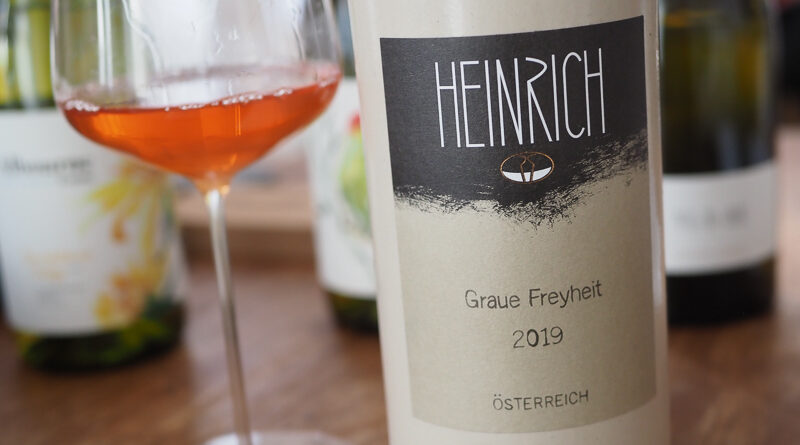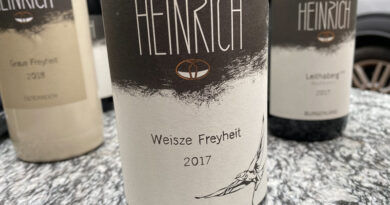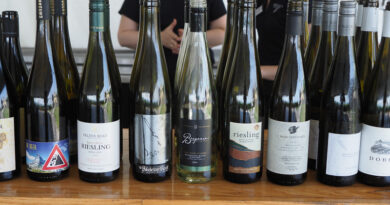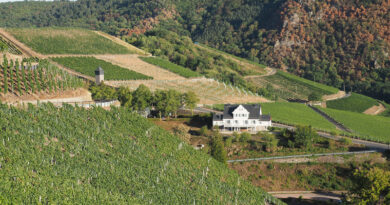The wines of Heinrich, one of Austria’s most singular producers
Jamie Goode and Treve Ring report on this important Burgenland producer
Gernot and Heike Heinrich are custodians of one of Austria’s most critically acclaimed wineries. Though Gernot’s first vintage was in 1985, at 21 years, he started Weingut Heinrich in 1989 in Gols, with 1 hectare of vines. They’ve grown that to around 100 hectares in Burgenland (85 owned, and 25 farmed), through turning out critic-friendly big red blends with ripeness and oak and concentration. Heinrich had converted to biodynamics in 2006, but it was in 2014 that they made a big style switch.
Gernot says that in 2014 they had a very cool vintage, which resulted in lighter-styled wines with much more elegance. These wines showed much more terroir character than he’d seen in previous years. This persuaded Gernot, who was 50 at the time, that he should make a style change from the richer, riper wines he’d made in the past. ‘Biodynamics is quite important to express our wines in that way,’ he says. They’re Respekt certified (an association which consists of wineries from Austria, Germany, Italy, and Hungary), though achieved Demeter certification in 2017. ‘Respekt covers only wine, but Demeter covers the animals and produce on the farm, which means a lot’ according to Gernot.
It wasn’t plain sailing though. One of the new house characteristics is some reduction in the wines. Good reduction. The American importers failed to understand this in the 2016 Blaufrankisch, and he had to take the wine back. And in the UK, their importer Liberty Wine dropped them: they are now with Indigo Wine.
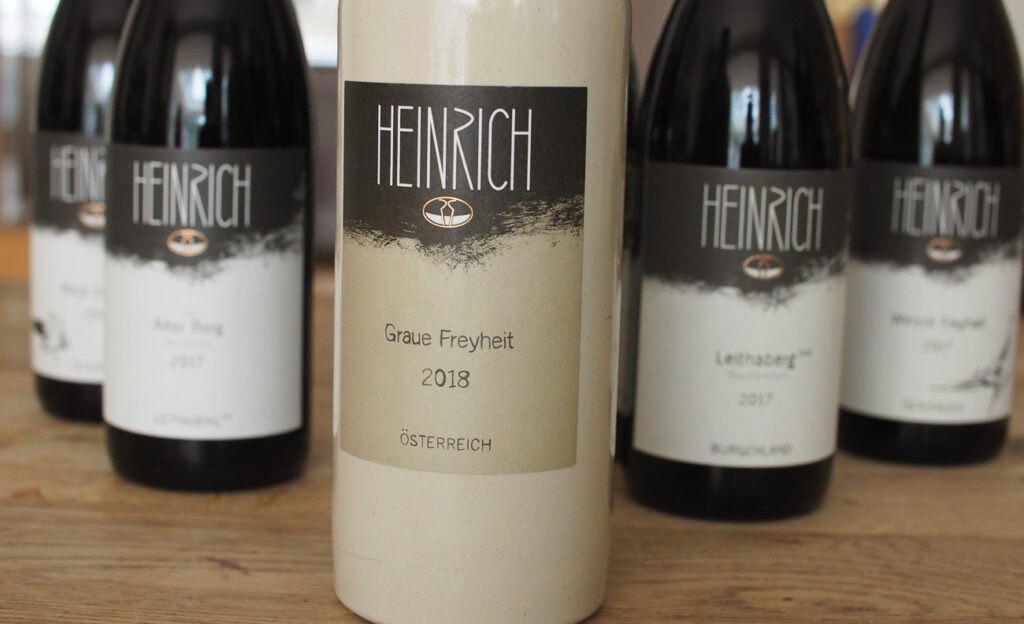
They use all the biodynamic preparations, and produce their own compost. In 2020, a very dry year, for example, they sprayed some horn manure to support growth, balancing the natural forces. They also use stinging nettle tea, which they mix with preparation 500, and spray these together.
They used to keep bare soil, they did green harvest and got big bunches. So they started working with cover crops to build up life in the soil. ‘This is the most important thing,’ says Gernot, ‘is building up the humus.’ The idea is to strengthen the natural immunity and resilience of the vines through a healthy soil. ‘This is the secret of biodynamic farming.’
‘We are situated in the most easterly part of Austria, close to the Hungarian border, so it is the driest, warmest area. It is influenced by the Pannonian climate and there is very low rainfall: the average rainfall is 400 mm. It is semi-arid, and sometimes there is no rain at all during the summer. Biodynamics is helping us get through these dry periods.’
How does biodynamics help with soil water retention? ‘You are improving the water-holding capacity in the soil, building up the humus. If I look at our vines now they are yellow/green and have low vigour, but they are resilient to all the diseases. You don’t get these fast growing, green leaves so there is better natural resilience.’
Gernot works a lot with lees, but not stirring or doing bâtonnage. ‘It is just waiting until all the microbes do their work in their wine.’ The acidity, he says, is the work of bacteria. ‘It is not just getting freshness from picking earlier, it is also important to finish all these degradations, all these processes going on in the barrel.’
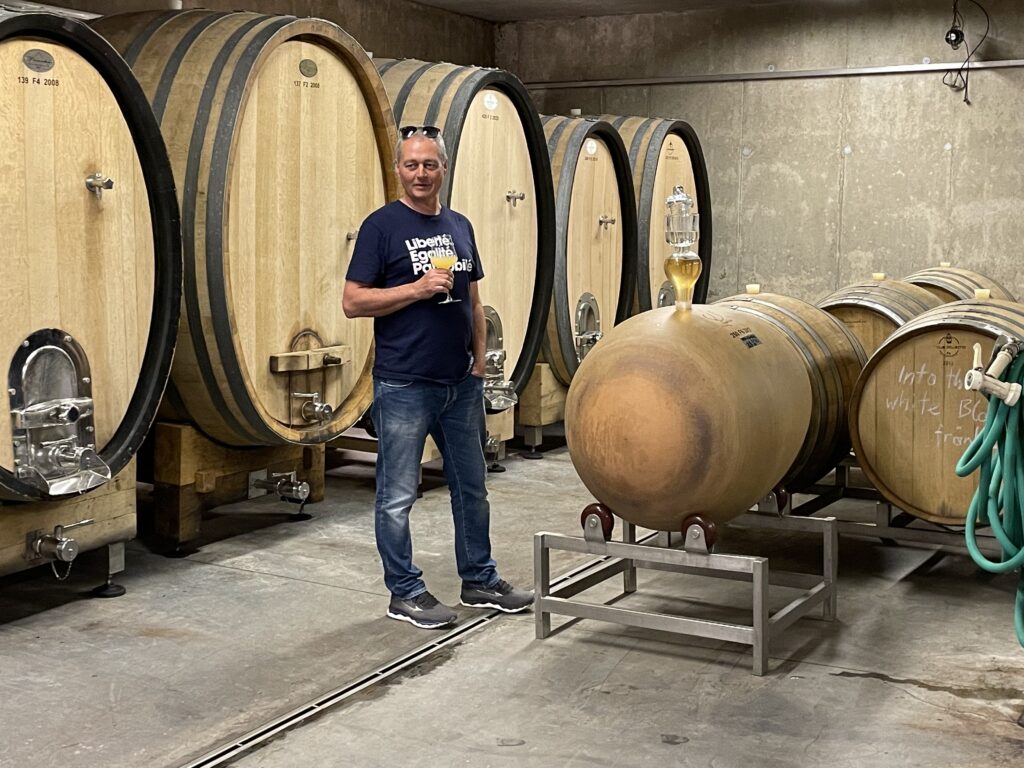
They have 120 Chinese made amphoras in the cellar, which are preferred for their lightness and thinness, as much as their highly competitive pricing. There are also 3 ceramic eggs in various cellar experiments. More recent vintages are seeing shorter skin contact time on the reds, while all whites are basket pressed, with some time on skins. Gernot planted Savagnin 2 years ago as a trial, slowly increasing their amount of white grapes (25% and rising).
There are four lines of wines. First of all, the Naked series, which is from good vineyards, but meets a price point, and these are very successful. Then the varietal series. Then the Freyheit natural wines (Freyheit translates as Freedom). And at the top of the tree we have the single vineyards. Ring visited the winery in May 2022, and her notes are below (TR).
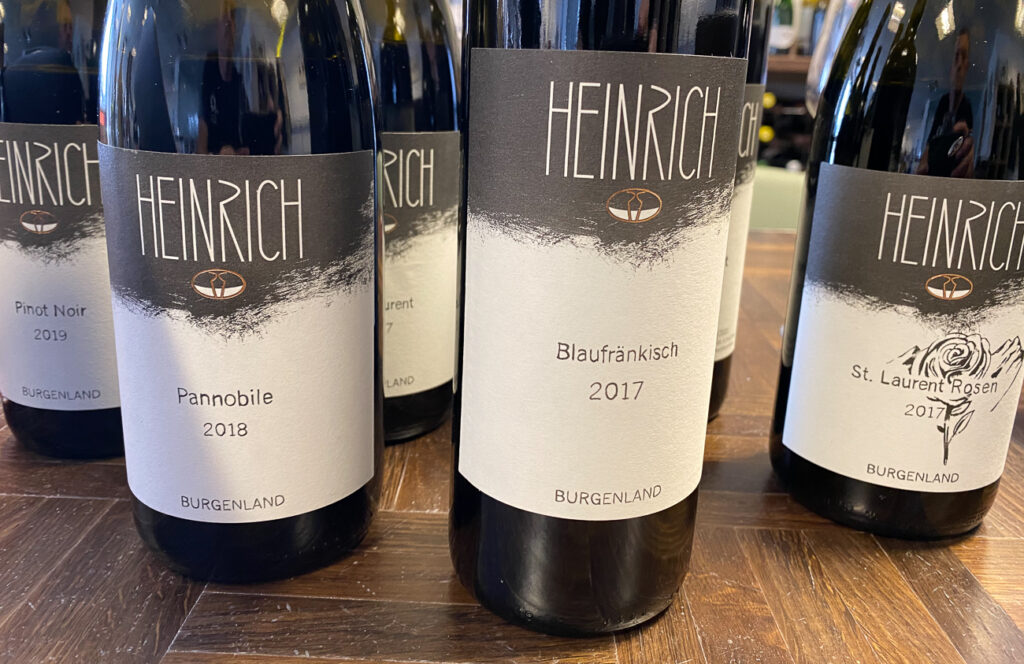
THE WINES
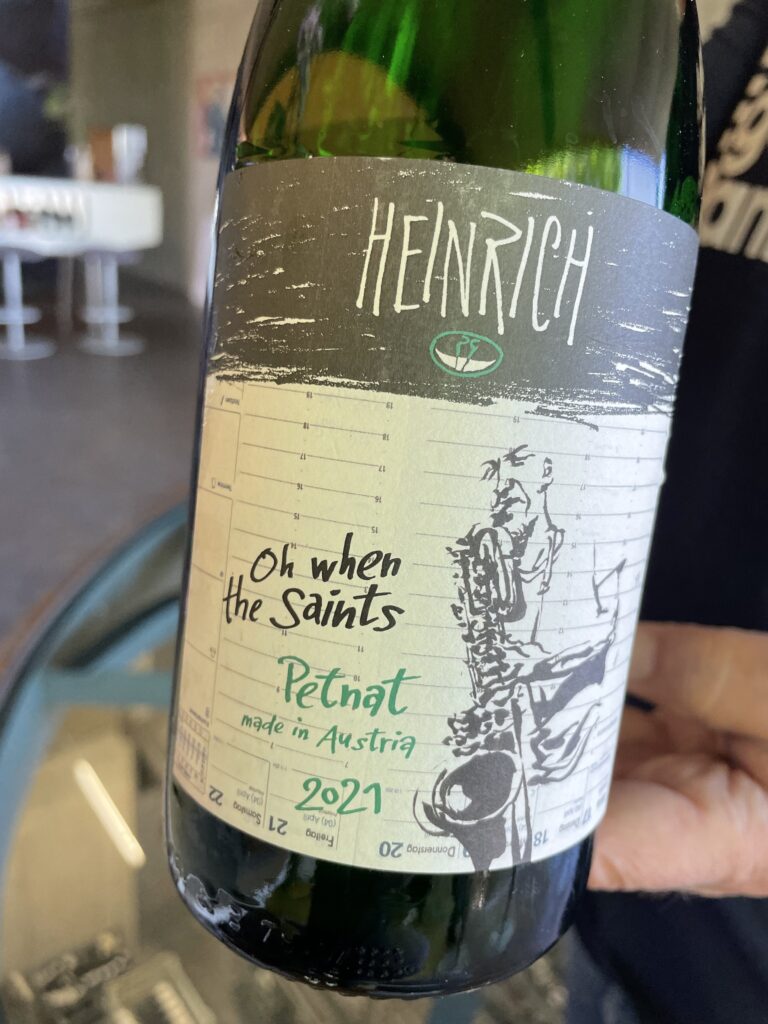
Heinrich Oh When the Saints St. Laurent Pet Nat 2021, Burgenland
10.9%, this was Disgorged 1 month ago. This St. Laurent was grown on mica schist, started native ferment in inox. Native ferment. Light apricot, green apple, bright pear skin, apricot fuzz and elderflower blossoms carries a lovely completeness thanks to a kiss of sweetness. Charming. 90/100 (TR)
Heinrich Naked White 2020, Burgenland
Naked and unadorned, this is meant to hide nothing. Chardonnay, Pinot Blanc, Muskat-Ottonel, Pinot Gris are sourced from vineyards on both sides of Burgenland’s Lake Neusidel, rooted into limestone, schist, gravel soils. After a native ferment in stainless, this rested 14 months on lees in large, older oak before being bottled unfiltered with minimal sulphur. Tight and nervy, with lemon pith, pear skin, bitter white grapefruit across a wash of broken stones, finishing with a sour lemon note. Lean and edgy natural rock juice. 11.5%. 88/100 (TR)
Heinrich Leithaberg Chardonnay 2019, Burgenland
Powerful, linear and intense with vivid citrus fruit and a nice pithy core. Oatmeal, nuts and some spice complement the powerful, linear citrus fruit with great acidity. This is classic barrel fermented Chardonnay with real precision and it’s potentially ageworthy. 93/100 (JG)
Heinrich Leithaberg Chardonnay 2020, Burgenland
12.5% alcohol. This is complex, intense and quite vivid with lovely citrus fruit complemented by some apple, pear and spice notes. Nicely structured, with a bit of grip under the lovely fruit. Mineral, with layers of spicy flavour. 93/100 (JG)
Heinrich Leithaberg Chardonnay 2021, Burgenland
From limestone. After overnight skin contact, the must goes into tank very brown. It was fermented in tank, then into oval casks. Green apple, apple skin, tight elderflower hums along the palate, lit with vibrant, buzzy energy, and strung with amazing tension. Lingering saline finish. 9000 bottles. 93/100 (TR)
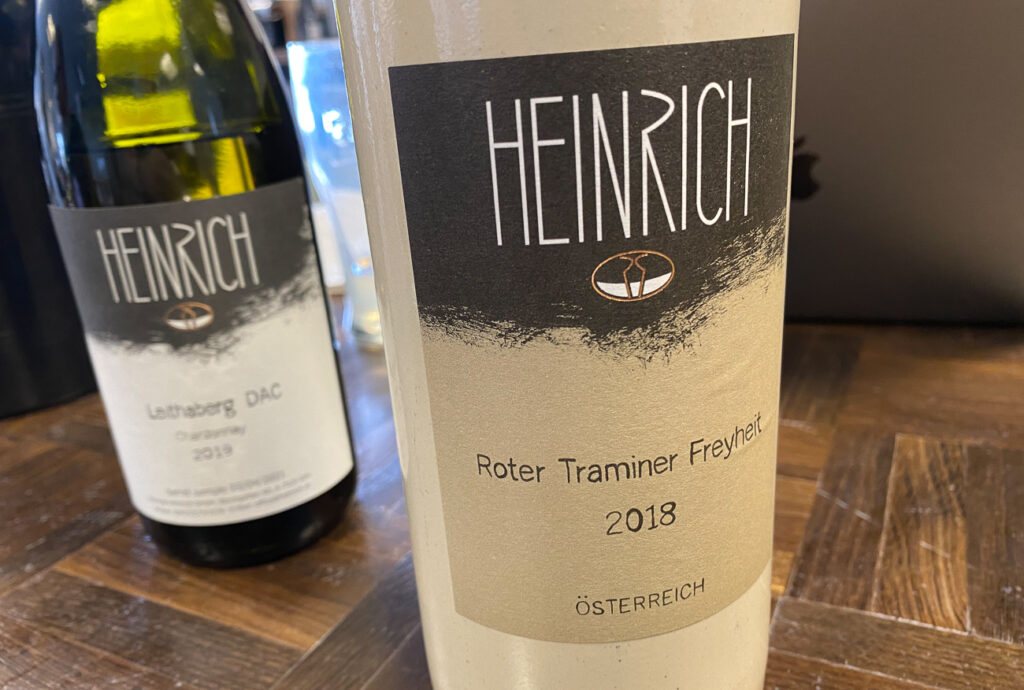
Heinrich Roter Traminer Freyheit 2018 Österreich, Austria
Beautifully perfumed with a jelly-like edge to the mandarin, lychee and lemons. The palate is lively and intense with good acidity and and lovely spiciness, with notes of melons and marmalade, as well as some lemony brightness. A really distinctive wine. 94/100 (JG)
Heinrich Traminer Freyheit 2021, Burgenland
Ceramic bottle. Mostly Roter Traminer on schist, with some limestone. Pouring a hazy cloudy yellow hue, with elderflower, apricot skin, lime peel, sour crab apple, on a textural, grippy palate, finishing with lingering white florals and salinity. 90/100 (TR)
Heinrich Muscat Freyheit 2019 Austria
12.5% alcohol. This is so pretty: it’s floral and grapey with bright fruit, a touch of lemon and some grapefruit pith. There’s a nice bitterness on the finish which helps make this an immensely food friendly wine. Textured and refined, but packed with flavour. Lovely stuff with a bit of bite. 93/100 (JG)
Heinrich Muscat Freiheit 2021, Burgenland
Ceramic bottle *Barrel sample out of amphora. Muscat Ottanel gives a lovely floral elderflower, apricot blossom, mandarin note, with big grippy texture from amphora across a mouthfilling, round palate. Finishes with big flake salts. 92/100 (TR)

Heinrich Graue Freyheit 2018 Austria
12.5% alcohol. In a ceramic bottle. 50% Weißburgunder (Pinot Blanc), 30% Grauer Burgunder (Pinot Gris), 20% Chardonnay fermented for two weeks on skins, and then aged in amphora and large oak. This is pale pink with some orange notes. It’s fresh and vital with lovely acidity and some thrilling mineral notes, as well as some cherry, redcurrant and lemon. Complex and a bit edgy with a twist of mandarin and some fine herbs. Such an interesting wine. 94/100 (JG)
Heinrich Graue Freyheit 2019 Austria
12.5% alcohol. Packaged in a distinctive ceramic bottle, this is a naturally made skin-fermented (2 weeks) wine from Pinot Gris, Pinot Blanc and Chardonnay, that sort of defies categorization. It’s a wonderful colour – a sort of combination of coral pink and bronze – and shows lovely pure sweet cherry, redcurrant and lemon fruit on the nose with just a hint of wax and quince jelly. The palate is fine, juicy and expressive with bright citrus fruit as well as redcurrant and a touch of pear. There’s some structure, but not too much (it’s not tannic), and there’s keen acidity. Really lovely. 94/100 (JG)
Heinrich Graue Freyheit 2020, Burgenland
Ceramic bottle. This is a blend of 50% Pinot Blanc, with the remainder Pinot Gris and Chardonnay (with the PB and Chard cofermented). Pours a hazy peach blush hue, thanks to 2 weeks on skins on amphora. Beautifully textural, with sour / crab apple, apricot skin, apricot blossom, meadow grass, elderflower, bergamot. Lovely salinity and energy on the finish. 93/100 (TR)
Heinrich Weisze Freyheit 2017 Österreich
No added sulfites. 97% Weissburgunder (Pinot Blanc) with 3% Moscatel Ottonel, with skin ferment. Amazing reductive mineral nose. On the palate this is really alive: bright lemons, lots of minerals, some pear and toast notes, and also a hint of melony richness. The overall impression, though, is one of amazing freshness. It’s so complex, mineral, spicy and multidimensional, with keen acidity and a bit of structure. An exercise in the mastery of reduction. I love it. 95/100 (JG)
Heinrich Weissburgunder Leithaberg 2014, Burgenland
Pinot Blanc (Weissburgunder) loves limestone. From the cellar, this pours a deeper yellow hue, and streams lightly caramelized popcorn on the nose. The bone dry palate is streaked with smoked stone, wild herbs, meadow grass, brown butter. Ample salts on the mid lead to a savoury warming finish. 91/100 (TR)
Heinrich Pinot Freyheit 2017 Österreich
11.5% alcohol. Pinot Noir. Matured 21 months in old 500 litre barrels and amphorae. Lots of whole bunch here. This is fresh and detailed with some real elegance, and spicy peppery notes under the cherry and plum fruit. There’s a nice raspberry edge to the fruit, as well as some grainy, spicy, earthy savouriness, and very fine green notes. Has some vital acidity, too, that lingers on the finish. This is really good. 93/100 (JG)
Heinrich Pinot Noir Freyheit 2019, Burgenland
From Edelgraben vineyard’s schist soils. 30% whole bunch. Smouldering plum, wild plum, wild blackberry, beauty spicing, black tea, lovely fine spicing through the saline finish. 91/100 (TR)
Heinrich Blaufränkisch 2017, Burgenland
12.5% alcohol. Floral and expressive on the nose with bright blackberry and cherry fruit. Supple with a slight tarry edge to the vivid raspberry and cherry fruit. It’s really focused and taut with a nice sour cherry finish. Really vivid. 94/100 (JG)
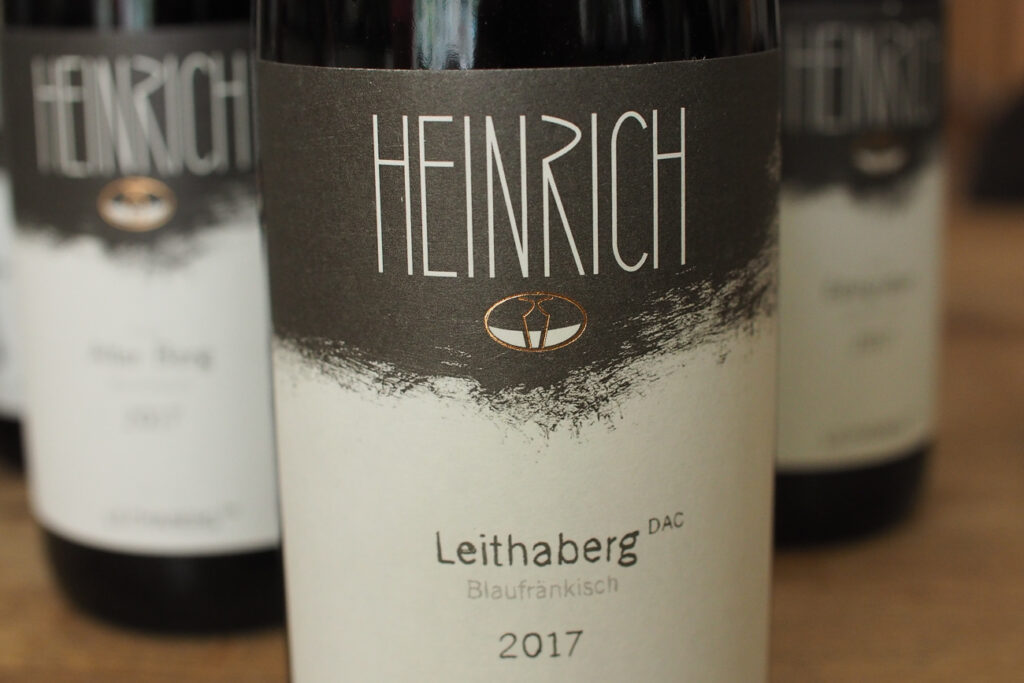
Heinrich Blaufränkisch 2017 Leithaberg DAC, Burgenland, Austria
13% alcohol. Various sites: fossil-rich limestone, calcareous sandstone, and mica schist soils. 20 months in used 500 litre oak barrels. This is quite structured and powerful, but still very fresh. There’s a brightness to the acidity, which frames the tannic black cherry and raspberry fruit really nicely. There’s also a chalky feel in the mouth. This is nicely dense and primary, with really good structure and some spiciness. Finishes bright. This has lovely structure from both acidity and tannin, and should age beautifully. 94/100 (JG)
From a mix of Leithaberg’s limestone, sandstone, mica schist soils, this spent 20 months in older 500L barrels. Wild plum, wild blackberry are layered throughout the tight, grippy, schistous frame. Finessed and understated, through the saline finish. 92/100 (TR)
Heinrich Blaufränkisch 2018 Leithaberg DAC, Burgenland
Same details as the 2017, though the 2018 is a darker, brooding example, with black plum, smoked stone, cured meats, studded with large flake salts. Quite savoury. Striking. 92/100 (TR)
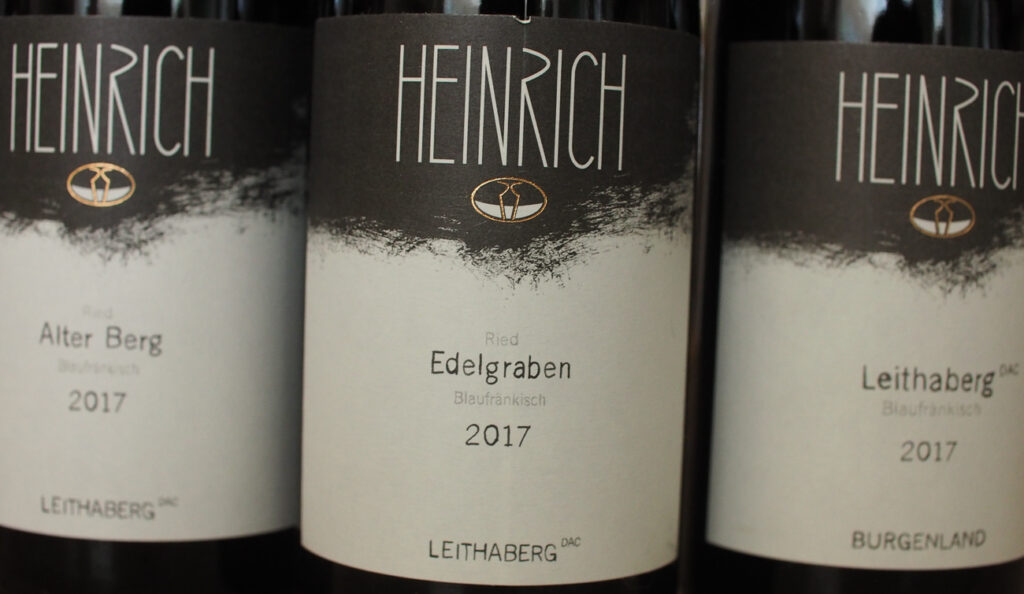
Heinrich Ried Edelgraben Blaufränkisch 2017 Leithaberg DAC, Burgenland, Austria
13% alcohol. 28 months maturation in used 500 litre barrels. This is fresh and focused with powerful, lively raspberry and cherry fruit and a nice acid line. Very focused and pure, with brightness and fine but firm structure. Shows a nerviness, too, that’s really beguiling. This has great concentration and depth and shows intense berry fruits, with firm but fine tannins. A long ager, potentially. 95/100 (JG)
From Edelgraben’s schist soils, this Blaufränkisch had near 30 months in older 500L barrels. Strucural and Douro-esque, with tight grippy sides texturing wild cherry, white pepper, and buzzy shining energy. 94/100 (TR)
Heinrich Ried Edelgraben Blaufränkisch 2018 Leithaberg DAC, Burgenland
Dusky, slatey, with dried florals and dark, brooding fruit framed by grippy tannins. Quite structural. Douro-like. 93/100 (TR)
Heinrich Ried Windener Alter Berg Blaufränkisch 2017 Leithaberg DAC, Burgenland, Austria
13% alcohol. Bony limestone soils with million-year-old fossils from a prehistoric sea. 29 months maturation in used 500 litre barrels. This is really vivid and pure with fresh, focused raspberry and cherry fruit. This has a brightness to the fruit, but there’s no lack of concentration. Bright red cherry and berry fruits here, showing a fine, pure fruit drive and lovely acidity as well as edgy, vital acidity. Such drive, but also elegance. This could age fantastically over the next decade. So taut and linear. 95/100 (JG)
From Alter Berg’s skeletal limestone soils, this Blaufränkisch spent near 30 months in used 500L barrels. So finessed and vibrant, with dark plum, wild blackberry, pure cherry streaking along a buzzy and tight palate. Time ahead yet, but so characterful and striking now. 94/100 (TR)
Heinrich Ried Windener Alter Berg Blaufränkisch 2018 Leithaberg DAC, Burgenland, Austria
Beauty slatey / stony notes (like licking rocks), this savoury red is muscular and elegant, built around acidity, with wild blackberry, wild plum playing a background role. Striking. 94/100 (TR)
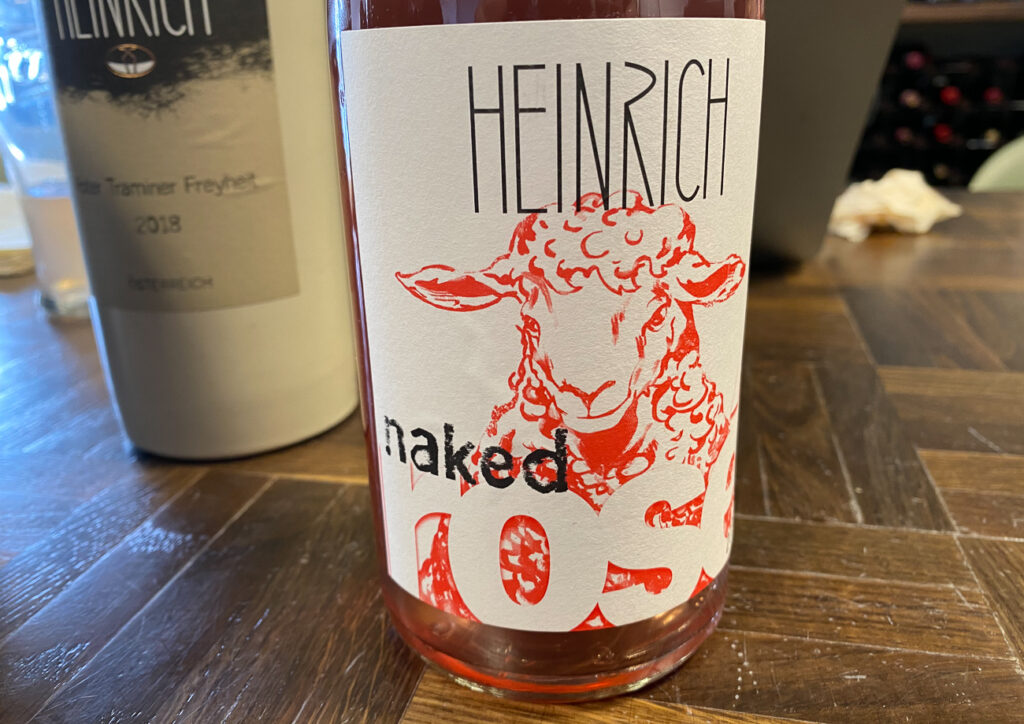
Heinrich Naked Rosé 2020 Österreich, Austria
11% alcohol. Mainly Blaufrankisch. Bright pink in colour, this is fresh, dry, lively and intense with vivid citrus and cranberry notes, with a very slight creaminess. There’s a touch of wildness and some sour cherry and yeasty notes on the finish. So fresh and intense, and amazingly drinkable. Something different here, and utterly drinkable. 91/100 (JG)
Heinrich Naked Rose 2021, Burgenland
Schist-soiled Blaufrankisch, direct press. Pale peach hue, this is tight and lean, with rhubarb, cranberry and a crunchy acidity, finishing very saline finish. no SO2. 88/100 (TR)
Heinrich Zweigelt 2018 (barrel sample), Burgenland
Vivid, juicy and intense with spicy structure under the vibrant raspberry and cherry fruit. It’s so fresh and expressive, and quite challenging in a good way. A vivid wine with great intensity. 92/100 (JG)
Heinrich Zweigelt 2019, Burgenland
*Tank Sample. Crushed florals, wild plum, violets, blackcurrants, tight, finely grippy tannins, tight energy. Lovely grippy texture. Fresh. 91/100 (TR)
Heinrich Pinot Noir 2019, Burgenland
12% alcohol. Juicy, spicy and linear with a green edge to the herb-tinged cherry and plum fruit. There’s a slight tarry reductive character with some greenness and a bit of tannin. Slightly awkward. 88/100 (JG)
Heinrich Pinot Noir 2020, Burgenland
Black raspberry, blackcurrant, cherry, wild plum, thorns. Negligible tannins, softer, darts of reduction. 88/100 (TR)
Heinrich Pinot Noir 2021, Burgenland
Tank sample from wooden vats. This year utilized 10% whole bunch, and Pinot Noir growing on both sides of lake (thus a mix of sedimentary, limestone, schist). Smoked earth, wild plum, wild blackberry, tart black cherry gives lovely lovely freshness and energy through the saline finish. Smart. 90/100 (TR)
Heinrich St. Laurent 2017, Burgenland
11.5% alcohol. Fresh, floral and juicy with nice bright red cherries and some fine herbal notes. It has a delicacy to it, with a touch of sour cherry on the finish and some green leafy notes. Lovely weight. A fresh, savoury wine. 92/100 (JG)
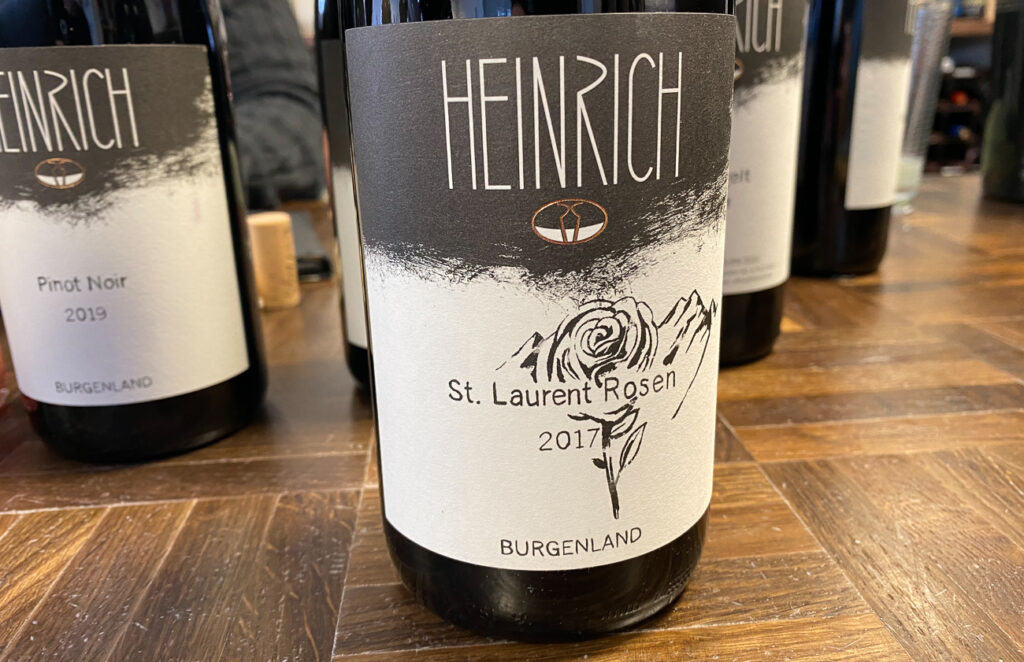
Heinrich St. Laurent Rosen 2017 Burgenland, Austria
11% alcohol. This is St Laurent aged for 26 months in Amphora. It’s naturally made. This is quite gorgeous. There’s just a hint of wildness on the nose (a little ghost of reduction), and the core of this wine is vivid, fresh, sappy cherry and raspberry fruit. There’s a stony, mineral dimension here, as well as a hint of blood and beetroot. There’s also well integrated greenness. Lovely focus and balance with brooding savouriness weaving in with fresh, vibrant fruit. A remarkable wine. 94/100 (JG)
Heinrich Cuvée Pannobile 2017 Burgenland, Austria
12.5% alcohol. This is fresh and juicy with vivid cherry and plum fruit. There’s some depth here, with a touch of blackcurrant and some dark gravelly notes. Fresh, vivid and nicely intense, in a classic style with the emphasis on the fruit, showing really good balance and a nice savoury twist on the finish. 93/100 (JG)
Heinrich Cuvée Pannobile 2018 Österreich, Austria
13% alcohol. 60% Zweigelt, 40% Blaufränkisch. Juciy and vivid with nice density to the bright black cherry and blackberry fruit. There’s some tannin here under the fruit with bright cherries and plums, and also a touch of raspberry. Nice grippy structure from the tannins and the acidity. Intense and with some weight on the palate. 93/100 (JG)
Pannobile started in 1992, when producers wanted to create an image for the top sites of the area in an effort to compete with Bordeaux. At that time, this meant more oak, and use of some Cabernet Sauvignon and Merlot. The founding members of the movement (all around the lake) made 1 wine / year under the Pannobile name, from top sites. The style and direction changed considerably over the years, into something more finessed and identifiably Burgenland. This vintage blends 60% Zweigelt, 40% Blaufränkish. Though a hot year, there is some lift here, with a lovely savoury nose leading into thorns, wild plums, white pepper, and big grippy tannins that are now sinking into fruit. Salinity goes long on the lengthy finish. 93/100 (TR)
Wines tasted January 2020 by JG:
Heinrich Naked Rosé 2019 Österreich (sample)
Unoaked Blaufrankisch, no added sulphites. Bright pink/orange colour. Bright and fruity with nice freshness. Has sweet strawberry and cherry fruit. Supple, drinkable and dry. 87/100
Heinrich Naked White 2017 Österreich
This is a white blend, with Chardonnay and Pinot Blanc dominant. First vintage, no added sulphites. This is nearly three years old and it’s still fresh, even without sulphites. Overnight skin contact. Full yellow in colour, this is lively, fruity and rounded with pear, table grape and spice notes. Very fruity with nice weight. 90/100
Heinrich Weisze Freyheit 2017 Österreich
No added sulphites. 97% Weissburgunder (Pinot Blanc) with 3% Moscatel Ottonel. Lovely reductive nose with matchstick and spice and minerals. This is spicy, mineral and intense on the palate. Lovely citrus, spice and pear, as well as some more exotic notes. 94/100
Heinrich Graue Freyheit 2017 Österreich
In a pottery bottle, this is a blend of Pinot Gris, Chardonnay and Pinot Blanc with 13 days skin contact, and then spends 17 months in large oak. A deep orange/copper colour, it’s quite a textured, harmonious wine with fine spiciness and pear and peach flavours, with a savoury framing. 93/100
Heinrich Pinot Noir 2018 Burgenland, Austria
Nice mineral reduction edge. Shows supple, bright red cherry fruit with herbs and spice, as well as the reductive notes. Very attractive juicy fruit style with a bit of complexity. 90/100
Heinrich Blaufrankisch 2017 Burgenland, Austria
Nice supple, light style. Shows supple raspberry and cherry fruit with a supple character and nice brightness. Such lovely drinkability. 92/100
Heinrich Leithaberg Blaufrankisch 2017 Burgenland, Austria
Very fine and supple. Fresh, pure red cherry fruit with some raspberry and nice acidity. Has grainy structure and nice purity. This is quite serious with elegance and finesse. 94/100
Many of these wines are available from The Sourcing Table in the UK (I declare an interest as contributing editor)
Find these wines with wine-searcher.com

